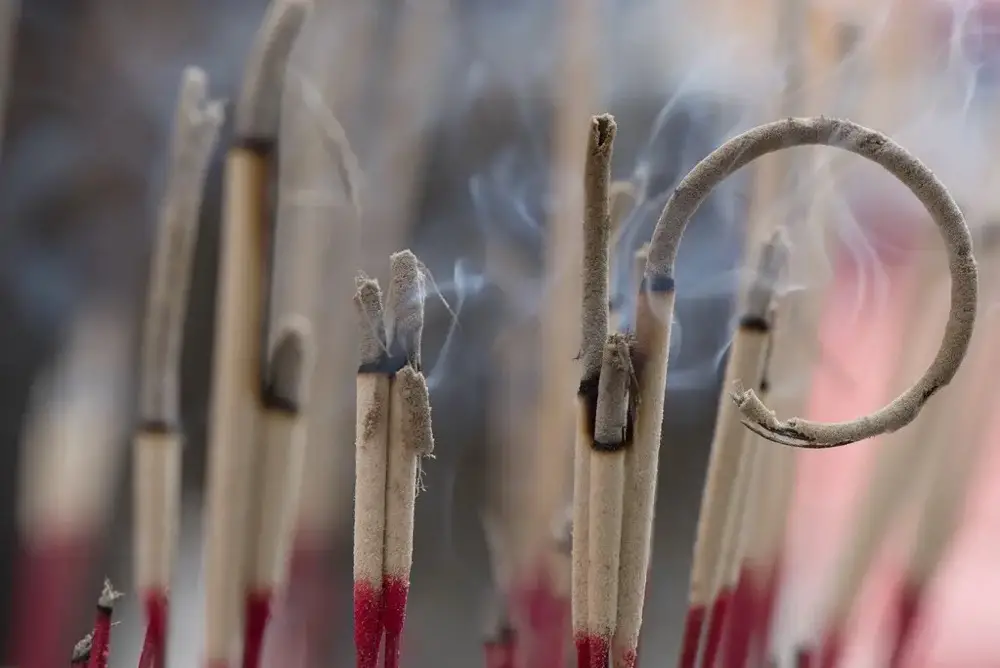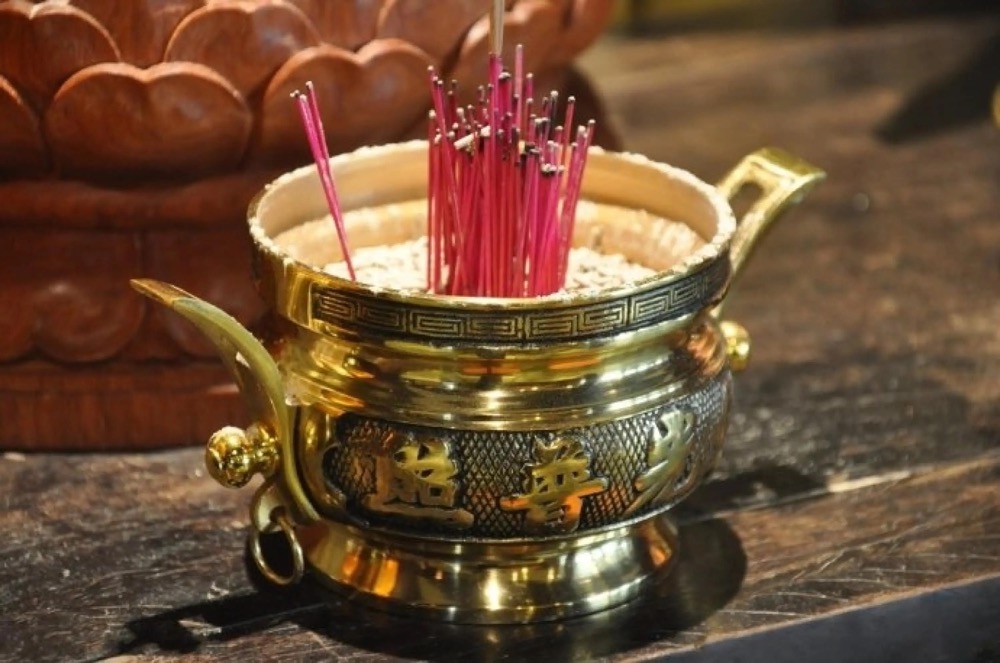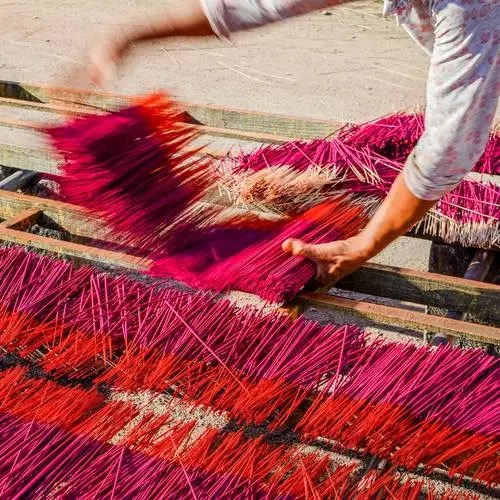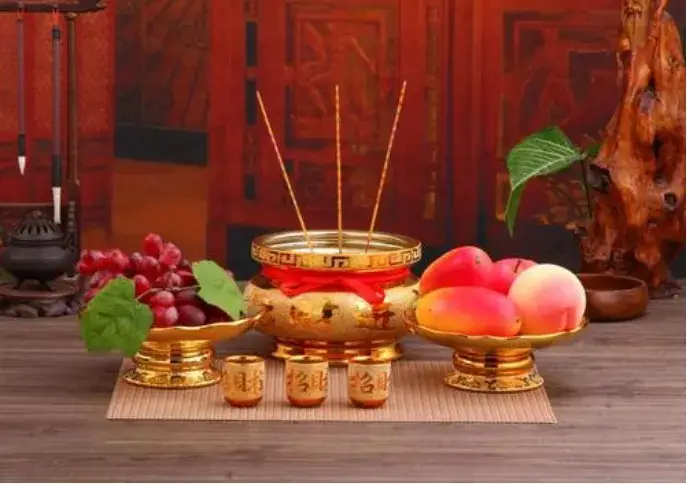Burning a joss stick is a traditional part of worship in several Asian countries and is common among those who practice Taoism, Confucianism, Chinese folk religion, and Chinese Buddhism. The upper portion of the stick is coated in a paste made from joss wood dust, which comes from materials such as machilus wood or cinnamon tree. Joss sticks may be adorned with carvings such as deities, phoenix motifs, and dragons. Small joss sticks can be coreless or have bamboo stick cores covered with joss wood dust and water paste, while large ones are made by layering joss dust dough onto a wooden stick.
What Is the Difference Between a Joss Stick and an Incense Stick?

Incense sticks are sticks covered with perfumed plant materials, sometimes infused with essential oils, that are rolled onto or in the shape of a stick that gives off a fragrant smoke when burned. The fragrance can be used in several ways, such as to aid meditative practice, for relaxation, for ceremonial and religious rituals, to deter wicked demons and pacify gods with its pleasant fragrance, or even to mask unpleasant smells or repel bugs.
Joss sticks are a type of incense stick. The difference between a joss stick and any other incense stick is that, traditionally, a joss stick is burnt in front of a joss—a Chinese idol or religious statue.
Several reasons for this practice have been given. Some say that burning joss sticks is meant to purify the worship space and create a tranquil mood. Others take the burning of the joss stick as a form of offering.
History of Joss Sticks
Although the recorded use of incense especially for religious purposes can be traced to 3,300 BCE, the recorded history of joss sticks goes back to just the first century CE. This record by Chinese poet Yu Jianwu (487–551) refers to the use of calibrated incense sticks as timekeeping devices in Buddhist monasteries. The practice seems to have moved into Chinese society from here.
In India, the use of incense sticks flourished in the early 1900s when the Maharaja, King of Mysore, introduced the idea of rolling incense paste onto bamboo sticks and developed it into popular art. These thin sticks were easy to use at home and in small spaces.
Incense-stick burning has, for close to two centuries, been a daily practice in Chinese religion. Joss sticks come in different types and colors for different purposes.
Most are long and thin. The thick ones are used in particular ceremonies, such as funerals. Spiral sticks have long burn times and are mostly found in temples. In some places, such as Malaysia, Singapore, or Taiwan, you can find large, dragon incense sticks that are burned outside during the celebration of the Ghost Festival. Joss sticks come in red, yellow, and sometimes black.
What is Joss Stick Made of?

Joss sticks are made of a supporting core, joss wood dust paste, and an outer protective coating.
Joss sticks are a type of direct-burning incense. It is the paste that burns, which is the top part are made of joss stick. Joss dust is ground from sappy trees such as machilus wood that grows in Thailand, China, and Malaysia. Each joss stick has four layers of this paste, with the outermost layer smoothened to give a good finish.
For large joss sticks, the dust and water are made into a dough that a piece of wood is layered with. Each layer takes about two weeks to dry before the next is added. This means a large joss stick takes about two months to layer the joss dust paste before the cravings are added.
The carver will use a knife, a rolling pin, or a wooden model to make each design. It takes between half an hour and ten hours to finish, depending on how intricate it is. After the design is complete, a coat of clear polyurethane is applied for protection.
Small joss sticks can be coreless, meaning they are made of 100% joss dust paste rolled into the shape of a stick.
How to Make Incense Sticks with Essential Oils
To make incense sticks you will need:
- Unscented incense sticks of about 30 cm. This you can get ready-made.
- Essential oils in the scents of your choice. Each stick will take about 20 drops of pure essential oil, so plan accordingly.
- Dipropylene glycol (DPG). DPG is used to reduce the black smoke burned by incense sticks. You will need 1 to 1.5ml of DPG per stick. (optional).
- A long, shallow container or dish to soak the sticks in. Use one that is not used with human or animal food, especially if you are going to use DPG. You can also make one out of aluminium foil.
Steps for making incense sticks using essential oils
- Lay an unscented incense stick on the flat container or dish.
- Mix the essential oils that you want to use and the optional DPG.
- Using a dropper, sprinkle the essential oil all over the unscented incense stick, covering the entire stick as much and as thoroughly as possible.
- Store the now-scented incense stick in a glass jar and let it dry for at least twenty-four hours.
- Once the incense stick or sticks are dry, they are ready for use.
Notes for making incense sticks with essential oils
- It is best to try one stick at a time to establish which scents work best for your needs.
- Some popular essential oils for your DIY incense sticks include rose, lavender, patchouli, sandalwood, and jasmine.
What is Joss Stick used for?
A joss stick is used in worship in Taoism, Confucianism, Chinese traditional religion, and Buddhism. Buddhists believe that burning a joss stick aids in divine communication. It also serves as an offering. Joss sticks are normally burnt as part of rites carried out during the fourth day after Chinese New Year; the seventh, the eighth, and the ninth moons in the lunar calendar; and during the birthdays of the heavenly deities.
When were Joss Sticks made?
Buddhist tradition holds that Buddha himself made the first stick. He then passed the know-how to his followers. In China, the earliest records of joss sticks go back to the first century CE. However, the use of incense for worship pre-dates this by several centuries. There is evidence of its incense use from other parts of the world, including in ancient Egypt, India, and parts of Asia as early as 3300 BCE, spreading to China around 2000 BCE.
How to use Joss Sticks

How Many Joss Sticks To Pray Ancestors?
According to Tibetan Buddhist tradition and rituals, you use one joss stick to pray to god and ancestors. This is the number that signifies preventing the violation of taboos, protecting against temptation, and giving you lucidity, intelligence, mental release, and endurance.
How to Light Joss Sticks
Joss sticks are used for veneration, and therefore, there is what is considered acceptable etiquette when it comes to lighting and stopping a burning stick. If you have a home altar or shrine and want to offer incense to Buddha, you start by lighting a candle. Hold your palms together and bow, then leave one of your hands in the palms together position and stretch the other to pick up and light the stick on one end using the candle.
Hold the stick in the candle flame until it ignites. Remove it from the flame, and if the stick is still flaming, give it a little shake to put off the flame, but leave a glowing ember. If there is no ember, it means the stick is not lit or burning properly, so hold it in the candle flame again. If successful, place the stick in the holder. Take care not to burn yourself or your surroundings while doing all this.
How Long Do Incense Sticks Burn
A standard incense stick will burn for between 20 and 40 minutes, depending on its length, thickness, and quality. Larger sticks will, of course, burn longer.
How To Put Out Incense Sticks
Water is the most effective way to put out an incense stick. Break off the stick slightly below the burning end and drop the piece with fire into the water. Don’t douse the whole stick as it might get too wet and not light up the next time.
How To Burn Incense Sticks Without Holder?
You can use a bucket or bowl filled with rice, sand, or salt. Push the stick’s bottom into the sand or other grain in the bowl so that it stands on its own. The ash from the burning incense stick will fall on the grain. You can also angle it if the bowl is large enough. Just make sure the tip is within the bowl.
How Many Incense Sticks To Burn A Day?
One incense stick per day is enough. The scent and effect are likely to last for about 24 hours. However, if you are burning incense sticks for worship, then you will need to burn as many as prescribed in the rituals. According to the Buddhist ritual, the incense sticks you burn will be in odd numbers.
How Many Incense Sticks To Burn For Good Luck?
You need to burn three incense sticks for good luck. These are supposed to help you move towards equilibrium, stability, and infinity.
How Many Incense Sticks To Burn For The Dead?
For the dead, some suggest you also burn three sticks. Three sticks represent the motion towards stability, equilibrium, and infinity. Others hold that seven incense sticks will serve you well, as they are supposed to bring peace to roving souls.
How Many Incense Sticks To Burn For God?
One incense stick to burn for god. One stick is the “incense of the heart.” It means preventing the violation of taboos, protecting against temptation, and giving you lucidity, intelligence, mental release, and endurance.
How Many Incense Sticks To Burn For Love?
Spiritual practices hold that burning three incense sticks will bring love to your heart. Whatever kind of love you need, be it for a woman and a man or in the family, burning three incenses will be helpful, according to Buddhism.
Incense Sticks meaning
Black Incense Sticks’ Meaning
Black incense sticks are used to banish evil energy and malice. They are meant to put an end to every bad situation. To do this, it is recommended to burn three incense sticks at the same time.
1 Incense Sticks Meaning
One incense stick emphasizes everything related to spirits and ghosts in a house. It represents the whole, unity, and fusion of the female and male principles. Buddhists light one incense stick when they want to release the “incense of the heart”, to prevent violation of taboos, protect against temptation, gain lucidity and intelligence, emancipation, and for endurance.
2 Incense Sticks Meaning
Burning two incense sticks is uncommon, if not unheard of. Most people, especially in Asian countries, burn incense sticks almost exclusively in odd numbers as they are considered lucky. The most favoured numbers to burn are 1, 3, 5, or 7 sticks. Even numbers such as 2, 4, and 6 are considered to bring bad luck, which no one wants to have.
3 Incense Sticks Meaning

The three incense sticks are all about worshipping Buddha, Dharma, and Sangha. You burn three incense sticks to lord Buddha when you are facing challenges and wish to get rid of them. Burning 3 incense sticks is the most common practice and is the number used for good luck.
Three sticks represent the motion towards stability, equilibrium, and infinity.
Conclusion
Studies have shown breathing incense smoke increases the risk of cancer. That being the case, it would serve you well if you avoided breathing incense as much as possible, and under no circumstance do it all day long if you must. There is a less harmful, less polluting alternative which is to offer dried petals instead of incense. The petals can be disposed of as compost once the offering bowl is full. In some temples, people are now encouraged to offer less grandiose joss sticks by being supplied with a limited number of sticks per person to reduce the level of population.